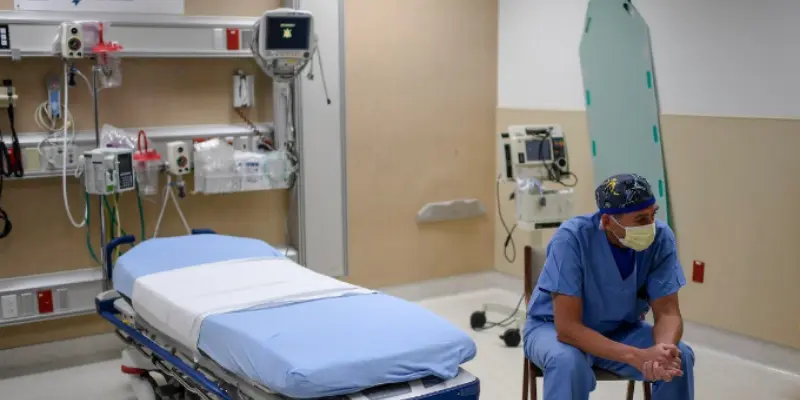NON-COVID 19 ED Visits Fell for All Acuity levels During Pandemic
A 40 % decrease in ED visits for urgent, unavoidable situations shows that many people with severe health problems avoided emergency rooms during the first phase of the Pandemic.
According to the latest study article, a total 35% drop in ED visits has been reported during and before the coronavirus pandemic in St. Louis-based healthcare systems. The country saw widespread declines in ED visits during the Pandemic. Reasons for ED avoidance include the concern of coronavirus contracts in medical environments, residence orders, and more outstanding school-based care.
The latest study, which was published this week in Health Affairs, looked at data from more than 1.2 million ED visits at BJC HealthCare for non-COVID-19 diseases from January 2018 to June 2020. In addition, the study looked into whether lower emergency room visits were linked to insurance status or race.
The study’s co-authors noted that understanding whether ED avoidance varies with race or insurance status is crucial to ensuring that vulnerable communities do not experience worse outcomes from non-COVID-19 diseases as the pandemic waxes and flows across the country.
Major data points included in the study

- After the city and county of St. Louis issued stay-at-home orders, the number of non-COVID-19 ED visits dropped by 35%.
- During the initial phase of the Pandemic, non-COVID-19 ED visits fell across all acuity levels. Nonemergent visits decreased by 52%, primary care-treatable visits decreased by 47%, preventable visits decreased by 46%, and nonpreventable visits decreased by 40%.
- The number of visits for mental health issues has decreased by 32%. However, the number of visits for alcohol and drug abuse did not fall in a statistically meaningful way.
- There were significant reductions in ED visits based on insurance status. ED visits by privately insured patients have decreased by 46%. ED visits by Medicaid patients have reduced by 44%. Uninsured patients’ trips to the ER dropped by roughly 40%.
- There were no statistically significant variations in the drop of ED visits according to race. The great majority of the study’s patients were either White or Black.
The COVID-19 Pandemic has linked with a significant decrease in non-COVID-19 ED visits across all acuity levels, a lesser reduction of visits for mental health difficulties, and no reduction of visits for drug use disorders. These findings show a need to educate the public about health issues that necessitate prompt ED care and increase access to alternate, lower-risk locations of care, particularly for populations with social or medical risk factors. “The co-authors of the study noted.
DATA INTERPRETATION
The co-authors believe that many individuals with significant health concerns avoided the ED during the early period of the Pandemic. The 40% drop in high-acuity ED visits shows that many ‘missing’ patients should have sought ED care for diseases such as heart attacks and strokes. Many people’s fear of developing COVID-19 may have overshadowed even severe symptoms.
According to the co-authors, the Pandemic’s behavioral health aspects likely explain why there was a relatively moderate drop in ED visits for mental health issues but no drop in ED visits for substance addiction.
The Pandemic’s high levels of anxiety and stress, as well as the disruption to everyday life, may have aggravated mental health and substance use disorders to the point of offsetting declines in these visits that would have otherwise happened due to ED aversion. It’s also probable that limited access to outpatient care for these health concerns prevented significant reductions in linked ED visits. They put pen to paper.
According to the co-authors, the comparatively high frailty of Medicare patients explains why they experienced the slightest drop in ED visits categorized by insurance coverage.
The relatively high frequency of chronic diseases among Medicare beneficiaries and the lower primary health or telehealth thresholds may explain why older individuals are referred for ED testing. However, the co-authors have also written that overall health is a possible explanation why the number of ED visits classed as insurance is falling most in private individuals. While a varied population in age, income, and medical risk is privately insured, they are younger and have lower average co-morbidities than Medicare’s patients.
The co-authors wrote the discovery that reductions in ED visits had not been linked to race.
Data from the national survey have shown that there are high fears of COVID 19 in patients in Black and that the chances of avoiding emergency treatment are more elevated than White patients even in complex medical situations. However, we found no variations in ED using habits in our specific group. It is unclear whether these findings relate to the particular features of our patient population; future studies on the use of additional databases are justified.
Resource: Christopher Cheney
Significant Takeaways
There were significant reductions in emergency department visits based on insurance status, with Medicare patients experiencing the slightest drop.
There was a minor drop in emergency department visits due to mental health disorders but no substantial drop in visits due to substance addiction.
Right Medical Billing is expert in Emergency Department Coding and Billing for Hospital based Emergency Departments and Free Standing Emergency Rooms, to learn more about Emergency Department Billing and Coding, call us at 281-864-0448.



